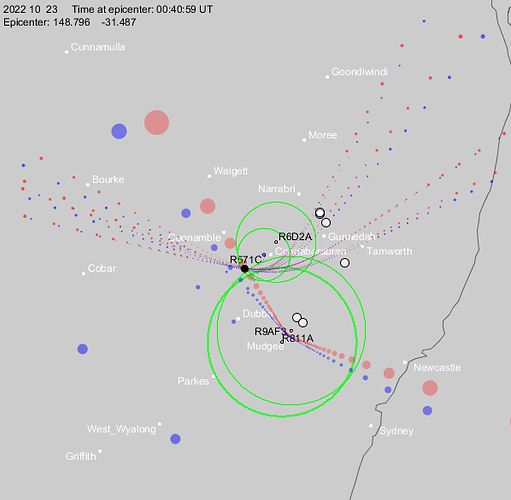A small local quake was picked up on several Shakes this morning
2022 Oct 2 00:49:59UT
Long 148.80E
Lat 31.49S
Assuming this was below the threshold for Geosciences Australia reporting it, is there a means by which RS would incorporate it in their database?
Date was 2022 Oct 23
Hello orez,
Thank you for this notification. Sometimes, with these smaller quakes, it can take a bit for them to be verified and then added to the databases of various agencies, GeoSciencies Austrialia in this case. In particular, if not many stations have managed to capture with enough clarity.
Regarding our RaspberryShake catalog, and why these events may not be automatically calculated and added in our system, the likely reason is that these types of calculations require a minimum number of stations of good data quality to generate an automated earthquake solution. If all the station provide excellent data, then 6 is the minimum requirement, but, as you also noticed, it can be hard to reach this treshold, so as quality depends on density, working with less than ten/twenty Shakes would make it difficult to precisely locate such small events.
Maybe, in the future, with more and more Shakes added to our network, this will become a reality. It is surely one of our objectives!
Thanks.
This was actually quite a high S/N event, being within 100km of the four Shakes. Similar S/N mine blasts give a mine location within a few km of the actual mine. Not knowing how to make a formal analysis using proper earthquake software, I wrote a simple program that is essentially just mathematics and assumes zero depth. If the event has significant depth, the calculated epicenter would be more diffuse. I’m a bit embarrassed to share the image below, but in my defense, this is very much a fleeting pastime for me - a bit of fun more than a scientific enterprise, but I would like to know how to do a formal analysis.
The red and blue dots give paired station estimates of distance for the P and S-waves with the dot size approximating the positional uncertainty. The green circles are from single station S-P time differences with the thickness of the line again approximating positional uncertainty. [The white circles are mine locations.] On the assumption that the depth is very shallow (reasonable, given the good consistency), the positional uncertainly seems to be of the order of 5km or so. I’d be interested in what a proper analysis using some physics (!) would come up with. The four Shakes are:
R571C
R6D2A
R811A
R9AF3
I believe there is only one Geosciences Australia seismometer this close (in Dubbo), others being hundreds of km more distant.
You don’t have to be embarrassed at all!
I would say that what you have done is already something that looks very interesting as a preliminary study! If this is only the first, we in the community look forward to what will be coming in the future.
Here are some online resources that I found that you can use to expand what you are researching:
But I’m sure there is more available than this fast search.
